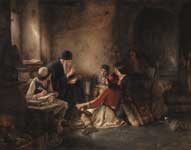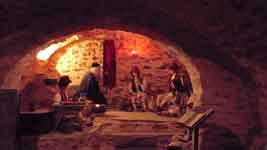.

The Secret School, Nikolaos Gyzis
In Greek history, the term Krifó scholió or Kryfo scholeio (Greek "κρυφό σχολειό" or "κρυφό σχολείο", lit. "Secret school") refers to allegedly illegal underground schools for teaching the Greek language and Christian doctrines, provided by the Greek Orthodox Church during the time of Ottoman occupation in Greece between the 15th and 19th centuries. The existence of such schools is today believed by scholars to be a national myth.[1, Alkis Angelou]
A traditional, popular belief in Greece today has it that the authorities of the Ottoman empire prohibited education in the languages of its Christian subject peoples. Greeks were therefore forced to cater for their basic education needs through small, secretly organized underground schools, which were run illegally in monsteries and churches. Alleged sites of such secret schools are today shown in many places in Greece. These schools are often credited with having played a decisive role in keeping the Greek language and Greek literacy alive througout the period of Turkish rule.
Against this view, it is now a consensus among most historians that there is no historical evidence that such schools ever existed. Within the Ottoman millet system, the Orthodox Church was responsible for most aspects of civil administration for the Christian population, and it had a high degree of autonomy in running its own affairs. Hence the church was free to run schools wherever it desired. The existence of many public, legally operated Greek schools is in fact well attested, especially in the larger towns after the 17th century,although the church never went so far as to organize a full-scale school programme for the whole of the population.
Τhe myth of the secret schools emerged after Greece had begun its War of Independece in 1821. The first mentioning of such schools has been traced to 1825, in a work of the German scholar Carl Iken, quoting information given to him by a Greek scholar, Stephanos Kanellos.[2,Alkis Angelou] The notion of the "κρυφό σχολειό" became more popular and more entrenched in the collective memory of Greeks through a painting of that name by Nikolaos Gyzis, of 1885-86 (today in the Emfietzoglou Collection, Athens). It depicts a romanticized scene of such a school, with the venerable figure of an old orthodox priest reading by candle-light to a group of boys and young men in the traditional attire of Greek klephts.[3,Antonis Danos]
Equally popular was a poem, of the same title, by Ioannis Polemis (1900). Its first stanza runs:[4]
Απ' έξω μαυροφόρ' απελπισιά,
πικρής σκλαβιάς χειροπιαστό σκοτάδι,
και μέσα στη θολόκτιστη εκκλησιά,
στην εκκλησιά, που παίρνει κάθε βράδυ
την όψη του σχολειού,
το φοβισμένο φως του καντηλιού
τρεμάμενο τα ονείρατα αναδεύει,
και γύρω τα σκλαβόπουλα μαζεύει.
(Outside, black desperation,
tangible shadow of bitter slavery,
but inside in the vaulted church,
the church which assumes every night
the shape of a school,
there is the shivering light of the candle
lighing up the dreams
and collecting the children of the slaves from all around.)
There is also a popular nursery rhyme, attested since the 19th century, which perpetuates the notion that such schools typically took place at night for greater secrecy:
Φεγγαράκι μου λαμπρό,
φέγγε μου να περπατώ,
να πηγαίνω στο σκολειό,
να μαθαίνω γράμματα,
του Θεού τα πράματα.
(My little bright moon,
shine on my way,
that I may go to school,
to learn to read and write,
and the teachings of God.)
Among scholars who argued against the existence of the "secret schools" already during the first half of the 20th century, Angelou[5] lists the historians Dimitrios Kambouroglou, Manuel Gedeon, and Yannis Vlachoyannis. One of the few scholarly works that have seriously argued for the existence of such schools was written by G. Chassiotis in 1881.[6]

A Hidden School "Kryfo Scholeio" in the monastery in Penteli
References
- Alkis Angelou: Κρυφό Σχολείο: το χρονικό ενός μύθου (Secret school: the chronicle of a myth. Athens: Estia, 1997.
- George Chassiotis: L'instruction publique chez les Grecs: depuis la prise de Constantinople par les Turcs jusqu' à nos jours. Paris, 1881.
- Antonis Danos: "Nikolaos Gyzis's The Secret School and an ongoing national discourse". Nineteenth-Century Art Worldwide 1 (2002). Online article
- Ioannis Polemis: "Το κρυφό σχολειό" Online text of the poem (in Greek).
- D. A. Zakythinos: The making of modern Greece: from Byzantium to independence. Oxford: Blackwell, 1976.
| Ancient Greece
Science, Technology , Medicine , Warfare, , Biographies , Life , Cities/Places/Maps , Arts , Literature , Philosophy ,Olympics, Mythology , History , Images Medieval Greece / Byzantine Empire Science, Technology, Arts, , Warfare , Literature, Biographies, Icons, History Modern Greece Cities, Islands, Regions, Fauna/Flora ,Biographies , History , Warfare, Science/Technology, Literature, Music , Arts , Film/Actors , Sport , Fashion --- |
Retrieved from "http://en.wikipedia.org/"
All text is available under the terms of the GNU Free Documentation License

